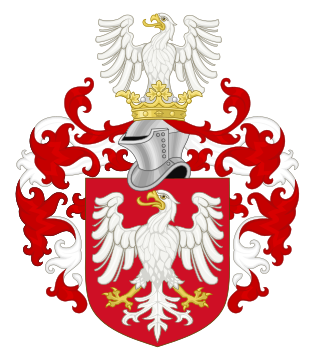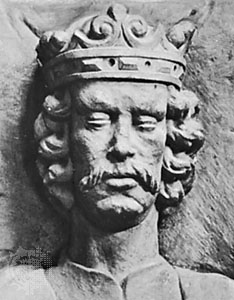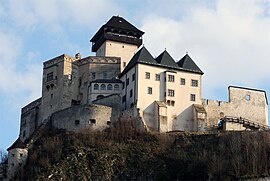
The House of Piast was the first historical ruling dynasty of Poland. The first documented Polish monarch was Duke Mieszko I. The Piasts' royal rule in Poland ended in 1370 with the death of King Casimir III the Great.

Henry II the Pious was Duke of Silesia and High Duke of Poland as well as Duke of South-Greater Poland from 1238 until his death. Between 1238 and 1239 he also served as regent of Sandomierz and Opole–Racibórz. He was the son of Henry the Bearded and a member of the Silesian Piast dynasty. In October 2015, the Roman Catholic Diocese of Legnica opened up his cause for beatification, obtaining him the title of Servant of God.

Władysław I Łokietek, in English known as the "Elbow-high" or Ladislaus the Short, was King of Poland from 1320 to 1333, and duke of several of the provinces and principalities in the preceding years. He was a member of the royal Piast dynasty, the son of Duke Casimir I of Kuyavia, and great-grandson of High-Duke Casimir II the Just.
Władysław II the Exile was the high duke of Poland and duke of Silesia from 1138 until his expulsion in 1146. He is the progenitor of the Silesian Piasts.

The Duchy of Greater Poland was a district principality in Greater Poland that was a fiefdom of the Kingdom of Poland. It was formed in 1138 from the territories of the Kingdom of Poland, following its fragmentation started by the testament of Bolesław III Wrymouth. In 1177, the state broke had separated into the duchies of Poznań, Gniezno and Kalisz, and united again in 1279, lasting in that form until 1320, when it was incorporated back into the Kingdom of Poland. Its capital was Poznań.

The Kingdom of Poland was a monarchy in Eastern Europe during the medieval period from 1025 until 1385.

The Duchy of Teschen, also Duchy of Cieszyn or Duchy of Těšín, was one of the Duchies of Silesia centered on Cieszyn in Upper Silesia. It was split off the Silesian Duchy of Opole and Racibórz in 1281 during the feudal division of Poland and was ruled by Silesian dukes of the Piast dynasty from 1290 until the line became extinct with the death of Duchess Elizabeth Lucretia in 1653.

The Duchy of Silesia with its capital at Wrocław was a medieval duchy located in the historic Silesian region of Poland. Soon after it was formed under the Piast dynasty in 1138, it fragmented into various Silesian duchies. In 1327, the remaining Duchy of Wrocław as well as most other duchies ruled by the Silesian Piasts passed to the Kingdom of Bohemia as Duchies of Silesia. The acquisition was completed when King Casimir III the Great of Poland renounced his rights to Silesia in the 1335 Treaty of Trentschin.
Bolko II the Small, was the last independent Duke of the Piast dynasty in Silesia. He was Duke of Świdnica from 1326, Duke of Jawor and Lwówek from 1346, Duke of Lusatia from 1364, Duke over half of Brzeg and Oława from 1358, Duke of Siewierz from 1359, and Duke over half of Głogów and Ścinawa from 1361.

The Duchies of Silesia were the more than twenty divisions of the region of Silesia formed between the 12th and 14th centuries by the breakup of the Duchy of Silesia, then part of the Kingdom of Poland. In 1335, the duchies were ceded to the Kingdom of Bohemia under the Treaty of Trentschin. Thereafter until 1742, Silesia was one of the Bohemian crown lands and lay within the Holy Roman Empire. Most of Silesia was annexed by the King of Prussia under the Treaty of Berlin in 1742. Only the Duchy of Teschen, the Duchy of Troppau and the Duchy of Nysa remained under the control of the Bohemian crown and as such were known as the Duchy of Upper and Lower Silesia until 1918.

The Duchy of Bytom or Duchy of Beuthen was one of many Silesian duchies. It was established in Upper Silesia about 1281 during the division of the Duchy of Opole and Racibórz among the sons of Duke Władysław Opolski. The duchy's capital was Bytom (Beuthen), formerly part of Lesser Poland until in 1177 the Polish High Duke Casimir II the Just had attached it to the Silesian Duchy of Racibórz.

The Silesian Piasts were the elder of four lines of the Polish Piast dynasty beginning with Władysław II the Exile (1105–1159), eldest son of Duke Bolesław III of Poland. By Bolesław's testament, Władysław was granted Silesia as his hereditary province and also the Lesser Polish Seniorate Province at Kraków according to the principle of agnatic seniority.

The Duchy of Głogów or Duchy of Glogau was one of the Duchies of Silesia ruled by the Silesian Piasts. Its capital was Głogów in Lower Silesia.

The Duchy of Brzeg or Duchy of Brieg was one of the Duchies of Silesia, created in 1311 during the fragmentation of the Duchy of Wrocław. A Bohemian fief from 1329, it was ruled by the Silesian Piasts until their extinction in 1675. Its capital was Brzeg in Lower Silesia.

The Principality of Opava or Duchy of Troppau was a historic territory split off from the Margraviate of Moravia before 1269 by King Ottokar II of Bohemia to provide for his natural son, Nicholas I. The Opava territory thus had not been part of the original Polish Duchy of Silesia in 1138, and was first ruled by an illegitimate offshoot of the Bohemian Přemyslid dynasty, not by the Silesian Piasts like many of the neighbouring Silesian duchies. Its capital was Opava (Troppau) in the modern-day Czech Republic.

The Treaty of Namslau or Namysłów, also known as the Peace of Namslau/Namysłów, was a peace treaty between King Charles IV of Bohemia and King Casimir III of Poland. It was signed at Namysłów in Silesia, on 22 November 1348 after the Polish-Bohemian War of 1345–1348.

Boleslaw III, called the Generous and the Wasteful was Duke of Legnica and Brzeg from 1296 until 1342, and Duke of Wrocław from 1296 to 1311.
Casimir of Bytom was a Duke of Opole during 1282–1284 and Duke of Bytom from 1284 until his death.

Duchy of Kraków was a duchy in Lesser Poland that existed from 1227 until 1300. Its capital was Kraków. It was formed in 1227 from the Seniorate Province, following the abolishment of the Duchy of Poland. It remained independent until 1300, when it had become a fiefdom within the Kingdom of Poland. In 1320, it was incorporated into the United Kingdom of Poland.

The Duchy of Opole and Racibórz was one of the numerous Duchies of Silesia ruled by the Silesian branch of the royal Polish Piast dynasty. It was formed in 1202 from the union of the Upper Silesian duchies of Opole and the Racibórz, in a rare exception to the continuing feudal fragmentation of the original Duchy of Silesia.


















